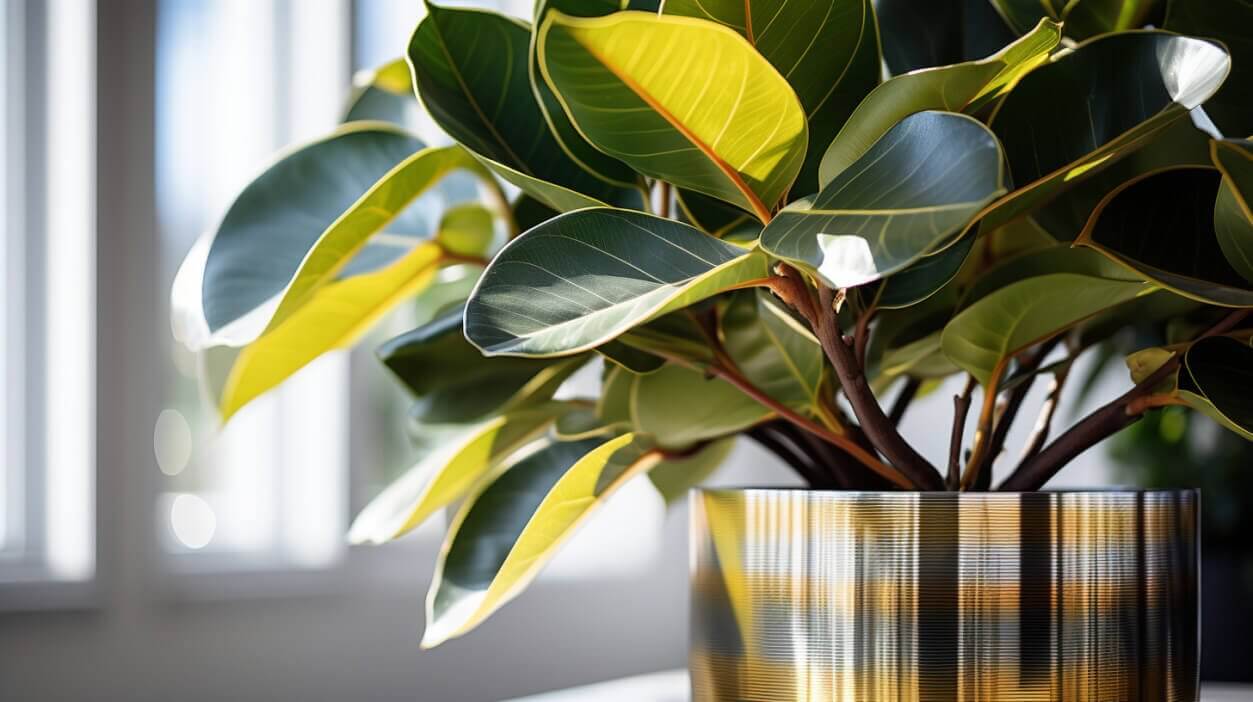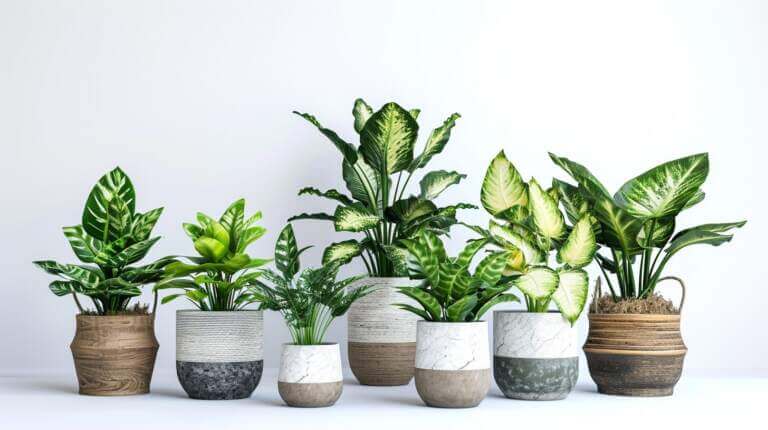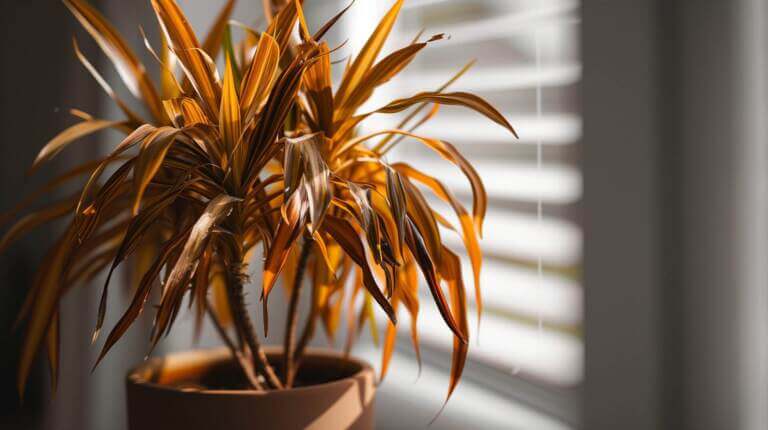Key Takeaways
- Light: Rubber plants like bright but indirect light. Try placing it near a window with sheer curtains.
- Water: Wait until the top 2 inches of soil are dry before watering your rubber plant. It should be kept moist and watered at least once a week during the growing season. If the room is dry, mist the plant regularly to increase humidity.
- Soil: You can use all-purpose potting soil for rubber plants.
- Temperature and Humidity: Rubber plants like average room temperatures and humidity.
- Fertilizing: During the growing season, feed the plant every 2-4 weeks. In spring and summer, it will benefit from a monthly liquid feed.
- Cleaning: Make sure to dust or wipe the leaves so they can photosynthesize properly.
- Propagation: You can grow new rubber tree plants by taking a small branch from a healthy tree and putting it in good potting soil or water to let it root.
Remember, these plants are not pet-friendly due to their milky sap that’s toxic if consumed. They’re best for households without small children and pets.
Rubber Plant Care Guide – Sunlight and Watering Requirements
The right amount of sunlight for rubber plants
As a proud owner of a rubber plant(ficus elastica), plants are easy you want to ensure it thrives and remains vibrant. One important factor to consider is the amount of sunlight your rubber plant receives. These plants prefer bright, indirect light, so placing them near a north or east-facing window would be ideal. Avoid direct sunlight, as it can scorch the leaves. However, too little light can result in leggy growth and dull-looking leaves. Striking the right balance will help your rubber plant flourish.
Watering tips for a healthy rubber tree
Keeping your rubber plant hydrated is crucial for its overall health. Here are a few helpful watering tips:
- Monitor soil moisture: Before watering, check the moisture level of the soil. Insert your finger about an inch deep into the soil; if it feels dry, it’s time to water.
- Avoid overwatering: Rubber plants do not like to sit in saturated soil. Water your plant thoroughly, but ensure the excess water drains away. Empty the saucer underneath the pot to prevent root rot.
- Establish a watering routine: Aim to water your rubber plant every 7-10 days, adjusting based on factors like the size of the plant, room temperature, and humidity levels.
- Use room-temperature water: Cold water can shock the plant’s roots, so make sure to use water at room temperature.
- Misting: Since rubber plants generally prefer humid environments, occasional misting can help provide moisture and improve humidity levels.
Remember, it is always better to underwater than overwater your rubber plant. Over time, you will become familiar with its watering needs and can adjust accordingly. Listening to your plant’s cues and observing any changes in its leaves will also guide you in maintaining a healthy and happy rubber plant.
Soil and Repotting Rubber Plant
When it comes to taking care of a rubber plant, two important factors to consider are the soil it is planted in and the need for repotting. By paying attention to these aspects, you can ensure that your rubber plant thrives and remains healthy.
Choosing the correct soil for rubber plants
First and foremost, it is crucial to choose the right type of soil for your rubber plant. These plants prefer a well-draining soil mixture that retains moisture without becoming waterlogged. A suitable option is a combination of peat moss, perlite, and potting soil. This blend provides the right balance of moisture retention and drainage, allowing for optimal root health.
The importance of repotting and when to do it
Repotting your rubber plant is another essential aspect of its care. As your plant grows, it will need a larger pot to accommodate its expanding roots. Repotting ensures that the plant has adequate space for growth and access to fresh nutrients.
So, how do you know when it’s time to repot your rubber plant? Keep an eye out for root-bound plants. If you notice roots growing out of the drainage holes or circling tightly around the inside of the pot, it’s a sign that your plant needs a new home. Additionally, if the plant becomes unstable and starts tilting to one side, repotting can help stabilize it.
It is best to repot during the spring when the plant is entering a period of active growth. Here are a few simple steps to follow when repotting your rubber plant:
- Choose a pot that is one size larger than the current one, ensuring it has drainage holes.
- Prepare the new pot by adding a layer of soil at the bottom.
- Gently remove the plant from its current pot, taking care not to damage the roots.
- Place the plant in the new pot and fill in the gaps with fresh soil, gently pressing it down to secure the plant.
- Water the plant thoroughly and place it in a location with bright, indirect sunlight.
By ensuring your rubber plant has the right soil and repotting it when necessary, you are laying a strong foundation for its overall health and growth. With proper care, your rubber plant will continue to thrive, adding beauty and a touch of green to your indoor space.
Fertilizing and Pruning
Fertilizer requirements for rubber plants
Hey plant enthusiasts! Taking care of your rubber plant is a rewarding and fulfilling experience. To keep your plant happy and healthy, it’s important to give it the right nutrients.
When it comes to fertilizing your rubber plant, it’s best to use a balanced, water-soluble fertilizer. During the growing season, which is usually from spring to early fall, you can fertilize your plant once a month. Use a diluted fertilizer solution, following the instructions on the packaging. Remember, over-fertilizing can harm your rubber plant, so it’s better to err on the side of caution.
Pruning techniques to promote growth and health
Pruning is a vital part of rubber plant care. Not only does it help maintain the plant’s shape and size, but it also promotes growth and keeps it healthy.
Start by inspecting your plant for any dead, damaged, or yellowing leaves. Using clean and sharp pruning shears, carefully remove these leaves where they emerge from the stem. This will help improve the overall appearance of your rubber plant and prevent any potential diseases from spreading.
If you notice your rubber plant becoming too tall or leggy, don’t worry! You can prune the stem to encourage branching and create a more bushy appearance. Identify the desired height and make a clean cut just above a leaf node. This will stimulate new growth and give your plant a fuller look.
Common Rubber Plant Problems and Pests
Identifying and treating common problems
Taking care of a rubber plant can be a rewarding experience. However, like any other houseplant, it can encounter some problems along the way. It’s important to be able to identify these issues early on and take the necessary steps to treat them.
One common problem with rubber plants is over-watering. If the leaves start to turn yellow and become mushy, it’s a clear sign that you’re watering it too much. Allow the soil to dry out between waterings and make sure the pot has proper drainage to prevent waterlogging.
Another problem that rubber plants may encounter is leaf drop. If you notice leaves falling off, it could be due to changes in temperature, drafts, or insufficient light. Try placing your rubber plant in a spot with bright, indirect light and avoid exposing it to cold drafts.
If you see brown spots or leaf discoloration on your rubber plant, it might indicate a fungal infection. To treat this, remove the affected leaves and apply a fungicide. Make sure to keep the plant in a well-ventilated area to prevent the spread of the fungus.
Preventing and controlling pests on rubber tree houseplant
Rubber plants are also susceptible to pests like mealybugs and spider mites. These pests can cause damage to the leaves and weaken the plant. To prevent infestations, regularly inspect your plant for any signs of pests.
If you notice small, white, cotton-like clusters on your plant, it’s a sign of mealybugs. You can remove them manually by wiping them off with a cotton swab dipped in rubbing alcohol. For spider mites, which appear as tiny red or brown specks, you can wash the plant with a gentle soap and water solution or use an insecticidal soap.
To keep pests away, make sure to regularly clean the leaves with a damp cloth and avoid overcrowding the plant with other plants. Maintaining proper airflow and humidity levels around the plant can also help prevent pests from infesting.
Taking care of a rubber plant doesn’t have to be difficult. With proper care and attention, you can ensure that your rubber plant stays healthy and vibrant. By identifying and treating common problems, as well as preventing and controlling pests, you can enjoy a beautiful and thriving rubber plant in your home.
FAQs About (Ficus Elastica) Rubber Tree Plant Care
How to grow and care for rubber plants outdoors?
Here are some tips for growing and caring for rubber plants outdoors:
- Light – Rubber plants need bright, indirect light when grown outside. Avoid full sun exposure which can scorch the leaves.
- Climate – They thrive best in warm, humid environments between 60-80°F. Provide shade if planting where summers are very hot.
- Soil – Grow in well-draining soil enriched with compost. Amend clay soils to improve drainage.
- Water – Water whenever the top few inches of soil become dry. Avoid moisture extremes.
- Fertilizer – Feed with a balanced liquid fertilizer every 2-3 weeks during the growing season.
- Pruning – Trim off any dead or damaged branches. Pinch back new growth to encourage bushiness.
- Pests – Watch for aphids, mealybugs, spider mites. Hose down leaves or use insecticidal soap.
- Overwintering – Move into a protected area or greenhouse if temperatures drop below 50°F.
With bright, filtered light and warm temperatures, rubber plants can adapt well in outdoor garden beds. Just take care to avoid excess sun and provide a little extra winter protection in cooler climates.
How do I care for a variegated rubber tree houseplant?
Here are some tips for caring for a variegated rubber tree plant:
- Light – Variegated Rubber plant needs more light, so try to give bright, indirect light to maintain the white variegation on the leaves. Insufficient light will cause leaves to revert to solid green.
- Water – Allow soil to partially dry out between waterings. Check the moisture level often as variegated plants drink more water.
- Humidity – Variegated Rubber trees are native tropical plants, mist leaves frequently or use a pebble tray to boost humidity which helps prevent leaf browning.
- Fertilizer – Feed monthly through the growing season with a balanced fertilizer to encourage new growth.
- Pruning – Snip off any all-green reverted leaves to promote variegation. Also prune to shape.
- Soil – Use a well-draining potting mix. Variegated rubber trees are sensitive to overwatering.
- Propagation – Take stem tip cuttings to preserve variegation when propagating.
- Temperature – Keep away from drafts and sudden temperature drops which can damage leaves.
With proper care to light and moisture needs, a variegated rubber plant makes a colorful, showstopping indoor plant. Just take care not to overwater or let leaves revert to solid green.
How do I care for a rubber tree plant?
To care for a rubber tree plant, make sure it is placed indoors where it can receive bright, indirect light. Water it when the top inch of soil feels dry, and be careful not to overwater as rubber plants don’t like to sit in water. Additionally, fertilize the plant monthly during the growing season and wipe the leaves with a damp cloth to keep them clean and dust-free.
How big do rubber tree plants grow?
Rubber tree plants can grow up to 100 feet tall in their natural habitat. However, when grown indoors, they usually reach a height of 6 to 10 feet. Regular pruning can help control the plant’s size and promote bushier growth.
Can I place my rubber tree plant near a window?
Yes, you can place your rubber tree plant near a window as long as it receives bright, indirect light. However, be cautious of placing it directly against the windowpane, as it may cause the leaves to become too hot or cold.
What are some care tips for a healthy rubber tree plant?
Some care tips for a healthy rubber tree plant include placing it in bright, indirect light, watering it when the top inch of soil feels dry, and keeping it away from cold drafts. Regularly dusting the leaves and fertilizing it during the growing season can also promote healthy growth.







